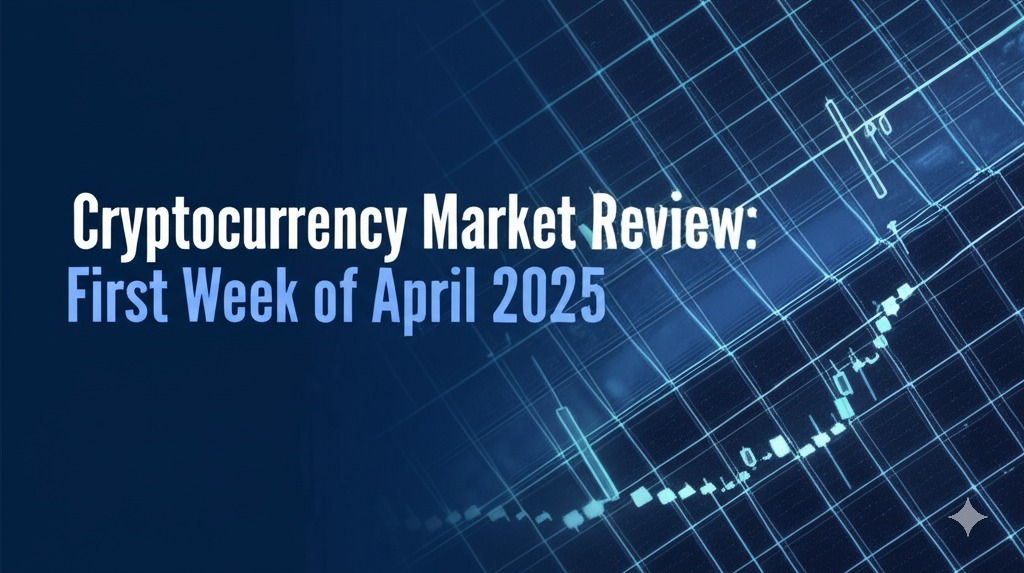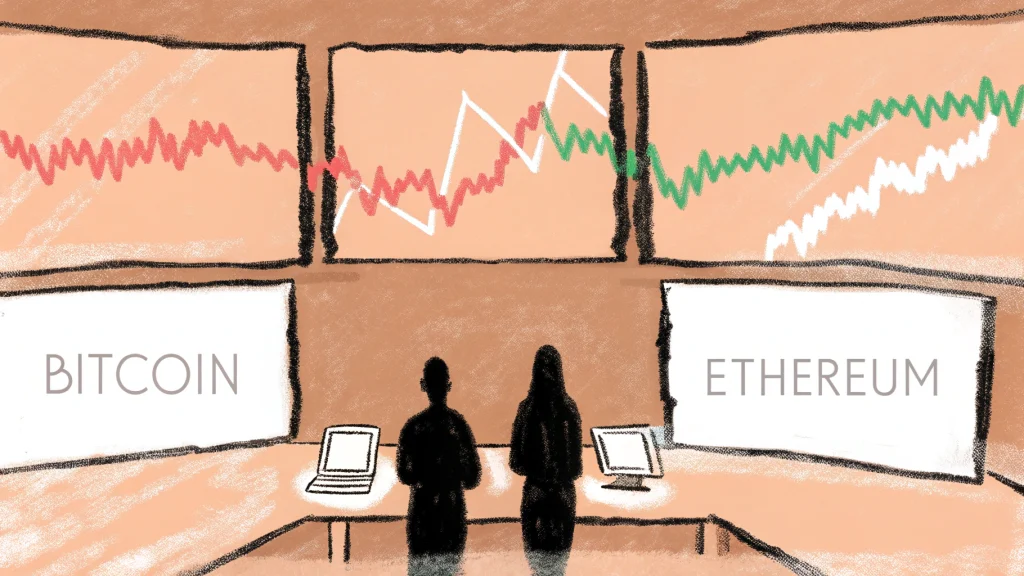Cryptocurrency Market Review: First Week of April 2025

April 8, 2025
The first week of April 2025 proved to be a microcosm of the broader cryptocurrency landscape: a volatile mix of macroeconomic pressures clashing with significant technological advancements and burgeoning institutional interest. While geopolitical tensions sent ripples of uncertainty through the markets, fundamental developments within major protocols provided powerful countercurrents, leaving investors to navigate a complex and rapidly shifting terrain.
Macro Headwinds: Trump Tariffs Trigger Market Jolt
The week kicked off with significant turbulence originating from Washington. President Donald Trump’s announcement of sweeping new trade tariffs sent immediate shockwaves across risk assets, including the digital asset space. On April 2nd and 3rd, markets reacted sharply to the news.
- Crypto-Related Equities Tumble: As reported by Reuters on April 3rd, crypto-linked stocks felt the pressure. Coinbase Global (COIN.O) saw a significant 7.7% decline, while MicroStrategy (MSTR.O) and major mining operations also experienced substantial drops.
- Digital Assets Dip: The tariff news directly impacted cryptocurrency prices. The Block noted on April 2nd that Ethereum and Solana fell around 6%. Investopedia confirmed Bitcoin’s decline following the announcement.
The immediate market reaction underscored the sensitivity of crypto assets to broader economic policy shifts. Data highlighted by Reuters painted a clear picture of the sell-off:
| Asset | Decline (%) |
|---|---|
| Coinbase Global (COIN.O) | 7.7 |
| MicroStrategy (MSTR.O) | 5.6 |
| Marathon Digital (MARA.O) | 8.3 |
| Riot Platforms (RIOT.O) | 8.7 |
| Bitfarms | 5.0 |
| Bitcoin | 3.9 |
| Ether | 5.2 |
Adding to the cautious atmosphere, Blackrock CEO Larry Fink’s comment on April 7th, suggesting the U.S. might “probably be in a recession right now” (CoinDesk X post), alongside reports of a global stock sell-off amid U.S.-China trade tensions (CoinDesk X post), further fueled market uncertainty.
Check this blog for more inforamtion: Navigating the Storm: Trump Tariffs, Crypto Volatility & Market Analysis (Apr ’25) .
Bullish Undercurrents: Bitcoin ATH & Ethereum’s Scalability Leap
Despite the tariff-induced volatility, fundamental forces within the crypto ecosystem provided significant upward momentum.

- Bitcoin Hits Record High: Driven by what reports describe as robust institutional buying, Bitcoin (BTC) surged, reportedly touching a new all-time high of $85,000 on April 3rd. This inflow of institutional capital signals growing conviction in Bitcoin’s role within diversified portfolios, even amidst macroeconomic uncertainty. Despite the mid-week dip, Bitcoin closed the week with approximately an 8% gain.
- Ethereum’s “Sharding” Success: A major technological milestone was achieved on April 5th with the successful implementation of Ethereum’s “Sharding” upgrade. This long-anticipated development aims to dramatically increase network transaction throughput, addressing scalability concerns and bolstering the Ethereum network’s capacity to support DeFi and NFTs. The market reacted positively, contributing to Ethereum’s roughly 6% gain over the week.
- Bitcoin Layer-2 Growth: Efforts to enhance Bitcoin’s transactional utility saw progress, with the Layer-2 solution “LightningFast” reportedly surpassing $1 billion in Total Value Locked (TVL), indicating growing adoption for faster, cheaper Bitcoin transactions.
Ecosystem Developments: Altcoins, DeFi, Regulation & Global Moves
Beyond the majors, the ecosystem saw varied activity:
- Altcoin Performance Varies: Altcoins saw mixed performance. Solana (SOL) experienced a notable price spike following news that the “VirtualWorld” metaverse platform would integrate an NFT marketplace powered by Solana, finishing the week up around 5%. Other major altcoins like Cardano (ADA) and Polkadot (DOT) saw more modest gains (around 1.7% and 2% respectively), reflecting a market potentially differentiating between specific project catalysts versus broader market movements.
- TradFi & DeFi Bridge: A significant partnership emerged between DeFi protocol “LendIt” and a traditional financial institution to offer crypto-backed loans to institutional clients, showcasing the accelerating integration between decentralized and legacy finance.
- EU Stablecoin Rules: On the regulatory front, the European Union unveiled new rules for stablecoin issuers, mandating licenses and reserve requirements. This move signals increasing regulatory scrutiny and a push towards greater oversight in key markets.
- XRP ETF Anticipation Builds: Market participants eagerly awaited the launch of the first U.S. XRP ETF. A CoinDesk X post on April 7th confirmed Teucrium’s 2x leveraged XRP ETF was set to debut today, April 8th. This anticipation likely contributed to market discussions throughout the week.
- Global Regulatory Landscape: On the global stage, notable developments included Changpeng ‘CZ’ Zhao being appointed as a strategic advisor to Pakistan’s Crypto Council (CoinDesk X post), signaling growing interest in formalizing digital asset frameworks in the region.
- Security Reminder: An unsuccessful, sophisticated hacking attempt on a major exchange served as a reminder of the persistent security risks requiring constant vigilance within the industry.
(Note: While Ripple’s significant $1.25 billion acquisition of Hidden Road was finalized on April 8th, as reported by Fortune and Cointelegraph, the deal announcement fell just outside the April 1-7 timeframe reviewed here.)

Outlook: Navigating a Complex Market
The first week of April 2025 demonstrated the complex interplay of factors driving the crypto markets. While macroeconomic policies like trade tariffs can induce significant short-term volatility, underlying technological progress (Ethereum’s Sharding) and sustained institutional interest (Bitcoin’s ATH) provide strong bullish foundations.
Analysts, like the pseudonymous “CryptoGuru,” cautioned about potential near-term corrections due to market leverage, reminding investors of the inherent risks. However, the continued evolution of DeFi, NFTs, Layer-2 solutions, global regulatory developments, and increasing institutional participation suggest a dynamic and maturing ecosystem. The week served as a potent reminder that investors must weigh external economic pressures against internal innovation and adoption trends when navigating the digital asset space.

